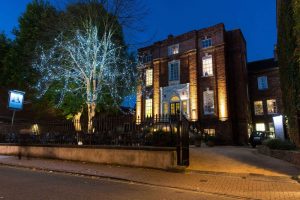Join us as we journey back in time. No pushing.
This month…
Ever had a drink, or indeed spent a night, at the hotel and bar on Lendal called The Judges’ Lodgings? Chances are you have, especially on a warm summer’s evening when that beer garden out front is totally inviting. However, have you ever wondered if the titular judges mind you supping a bev in their front yard, or why in fact such a grand building is nestled there, set back from a street lined with shops and bakeries? If so, read on you glorious wonderer…
Judging by the evidence
To peel back the history of what today is a very popular pub, we must first start, as we often do in dear old York, with a church. Occupying land between Lendal and Blake Street was once St Wilfred’s, a church so old it predated the Norman Conquest of 1066. That ancient structure was demolished some time after 1550, making it, and the connected burial ground, a prime city-centre location for development. Enter Dr Clifton Wintringham.
Dr Cliff was one of the leading physicians of the early 18th century, tending to the health of the likes of the Earl of Carlisle, the owner of Castle Howard. The good doctor required some fine lodgings within the city and so, between 1711 and 1726, the house was constructed on the site of St Wilfred’s burial ground. At the time of building it was reported that dozens and dozens of burials were discovered and, likely, completely ignored by the builders as they sank their foundations.
Judge not
The new house, with stone-carved fruit and depictions of Greek gods above the door, clearly caused a stir locally. Writer Francis Drake commented in 1736 that it was “one of the best built houses in the city”. Also, John Cossins, an early map-maker, included a drawing of the house in his 1727 New and Exact Plan of the City of York, to show off the city’s trend toward fashionable architecture. On that note, the architect is unknown, but it is thought to be the work of Lord Burlington who designed the Assembly Rooms just behind the house.
In 1746 Dr Wintringham was made the Physician of York County Hospital and enjoyed great success as a medical author and for the detailed meteorological records he kept; convinced that climate and health were linked. He died just two years later, survived by his son, Clifton Junior, who would go on to be the personal physician to King George III. Ooo…
Judge dread
So where are all the judges who, y’know, lodged here? Well, before we get to them, there is one interesting side note. The next resident of the house on Lendal was one Dr Dealtry, a chap you can visit today as a monument in York Minster. Dealtry occupied the house until 1773 and was most noted for refusing to remove the old headstones from the former burial ground which had been used to line the kitchen floor – inscriptions facing up! Dr Dealtry was quoted as saying “to familiarise ourselves with the emblems of death is the most powerful means of humbling human pride.” Bet he was fun at parties.
And so, in 1806, the house was bought by the County of York to act as lodgings for the Judges of the Assizes Court. Held at the Castle, where the Crown Court resides today, the Assizes were held every quarter and dealt with the most serious of crimes committed in the city and the county. The house was purchased to offer not only grand accommodation for the visiting judges, but also space for them to entertain.
Judgement Day
The now renamed Judges’ Lodgings were completely refurnished (we’re guessing the tombstones were ripped out) and a Mr and Mrs Kilvington were installed as resident housekeepers, living in the smaller wing to the south-east. The upper-most floor was used for the visiting Judges’ own servants, while the big-wigs themselves enjoyed grandiose suites with private chamber pot rooms. Cases were heard and fates decided by day, while at night the judges would drink and dine, attended to by a body of hard-working staff. Quite like the building of today, in many ways.
The Assizes Courts were abolished in the 1970s, but the Judges’ Lodgings had ended their tenure as actual lodgings for judges long before that. For many years empty, a small archaeological dig in the house in the 1980s revealed that, as well as cutting through the crammed medieval burial ground, the 18th century builders had also smashed right though a far older structure; a Roman building. The site – and this may have been the reason for that ancient pre-Norman church existing here at all – was once occupied by one the interval towers of the Roman defensive wall of Eboracum.
Something to think about the next time you’re huddled under a heater clutching your pint in the beer garden.











Add a comment